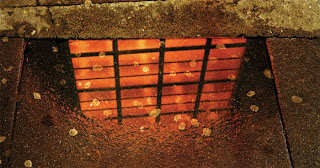Today I shot the object image again using a 5x4 Horseman again having booked the studio with three others members from group I some weeks ago.
I'd sketched out a rough idea of how I wanted the image to look yesterday (and blogged that), so I knew pretty much how to compose the image and from which direction I wanted my lighting to come from.
As usual I shot a few frames during the day on the digital camera for the blog:
 |
| Initial partial composition (before/whilst making numerous changes and exposure checks-hence quick disc etc) |
 |
| Final Lighting Method (although i forgot to add the barn doors to the diagram so excuse that omission) |
 |
| Lighting and equipment set up |
 |
| Contact on brown desk |
 |
| Contact on green desk |
Initial set up showed I needed to raise my main light, and I illuminated my background to remove an unsightly shadow which the objects created. I'd considered a fully dark or partially dark background, but wanted to represent an office space on a simplistic level, thus taking the lit/light background route.
The bin bag/recycling idea initial considered (with the bag initially being used on my first attempt at this brief) progressed into a symbolic desk/office with belongings boxed up and awaiting removal. Jonathan had previously discussed context (in relation to background) and content (in relation to the objects), and I wanted a stronger and simpler narrative. Offices generally contain desks and plain walls, and visually the boxing up of belongings I hope would be seen as a more familiar representation of the process of the final stage of redundancy. A P45 hinting (in a subtle way) at the end of a job, rather than the start of a new position, i.e moving out and not into a job! I was torn between diffusion and a harsher light, having experienced both types of light in the work place. Opting for a continuous lighting source (with gel colour correction) and a very deep depth of field (F45) to attempt to capture a sharpness throughout the image. I also wanted the text on the folders and some text on the ruler to be clear and readable, as well as text on the cup. I liked the idea of the "Shatter Proof" ruler as a metaphor.
I processed two negatives, then using some old film which is out of date I experimented by switching the desk for a different coloured (green topped) example, processing those negs also. I'd need to print the images to see how the two look and compare, as the contact sheets are both a little light (first time I've used the colour dark room contact sheet making facility). The negs look to be very sharp and i think the narrative is far more readable than my previous image.
Influences for the new idea come from sources/images such a:
 |
| image care of http://www.guardian.co.uk/society/patrick-butler-cuts-blog/2010/oct/27/lost-job-still-at-work (Image Rex Features http://www.rexfeatures.com) 30th Nov 2010 |
 |
| Image care of (Getty Images via) http://www.guardian.co.uk/money/blog/2011/jan/31/dear-jeremy-have-your-say (Image by Steve Cole http://www.stevecole.com) 30th Nov 2010 |
 |
| Image Care of http://www.dailymail.co.uk/home/you/article-1070329/Things-don-8217-t-know---Redundancy.html (Image by Bloom production)30th Nov 2010 |
"Self-made people thrive
They know where they’ve come from. And they dust themselves down, rely on their inner anger as fuel and try again.
The people that crumble are those who over-identify with their wealth and status; those who mistake income for personality or intelligence.
The people who are most successful are in touch with their inner core. They know what makes them great as human beings, irrespective of what they do.
It can make you a better person
Redundancy can give people a new lease of life. They can say, ‘To hell with it, I’m going to do relief work in Africa…to do what I’ve always dreamed of.’
It’s an opportunity to find your talents and your heart and to possibly pay much needed attention to your family.
It also generates an empathy with misfortune that may have been missing. And you can feel relief from the pressure of a job you weren’t aware you were carrying.
Suddenly you have a blank page. Scary maybe – but you can do anything with it."
Text also care of the daily mail article associated to the image in http://www.dailymail.co.uk/home/you/article-1070329/Things-don-8217-t-know---Redundancy.html 30th Nov 2010



























































 p
p